This short sequence is designed for anyone who wants to get started with a short, gentle home yoga practice. This sequence is a great complement to our Low Back Care Practice and Mini Restorative Practice because it focuses on upper body flexibility, strength and balance, which are not addressed by the other sequences.
Although I originally designed this practice, Baxter reviewed it and made a modification—so it is officially Dr. Baxter Bell approved. We both hope you enjoy the practice!
1. Standing Shoulder openers (see Opening Tight Shoulders).
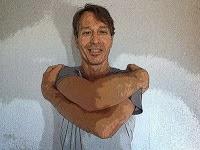 Releasing tight shoulders is important for the upper back and neck health, and is an important antidote for time spent in front of computers, driving, gardening, or other activities where you are reaching forward all day. If you have limited range of motion in one shoulder, just do the best you can, even if that means, for instance, taking your hand only half way up the wall rather than all the way. To make the sequence shorter, you could skip some of stretches (and alternate on different days of practice).
Releasing tight shoulders is important for the upper back and neck health, and is an important antidote for time spent in front of computers, driving, gardening, or other activities where you are reaching forward all day. If you have limited range of motion in one shoulder, just do the best you can, even if that means, for instance, taking your hand only half way up the wall rather than all the way. To make the sequence shorter, you could skip some of stretches (and alternate on different days of practice).2. Half Dog pose at the Wall (see Half Dog Pose at the Wall).
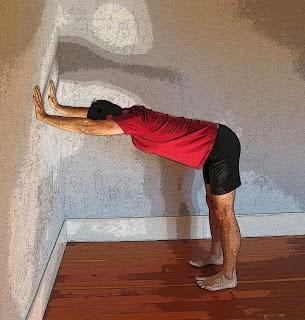 This pose is a wonderful all-over stretch because as it opens your shoulders it also stretches the sides of your torso, and, if you straighten your knees, it stretches the backs of your legs as well. It’s a perfect warm-up for standing poses!
This pose is a wonderful all-over stretch because as it opens your shoulders it also stretches the sides of your torso, and, if you straighten your knees, it stretches the backs of your legs as well. It’s a perfect warm-up for standing poses!3. Warrior 2 and Warrior 1 Mini Vinyasas (see Warrior 1 and Warrior 2 Mini Vinyasas).
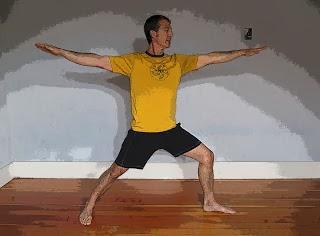 Warrior 2 and Warrior 2 are classic standing poses that improve your balance (due to their wide leg stance), build leg strength (due to the bent front knee) and increase upper body strength (due to holding arms out to the side or over head). Practicing these as mini vinyasas (moving in and out of the poses with your breath), while not as strengthening as holding the poses for extended periods, will improve balance and agility, and are a gentle versions of these poses.
Warrior 2 and Warrior 2 are classic standing poses that improve your balance (due to their wide leg stance), build leg strength (due to the bent front knee) and increase upper body strength (due to holding arms out to the side or over head). Practicing these as mini vinyasas (moving in and out of the poses with your breath), while not as strengthening as holding the poses for extended periods, will improve balance and agility, and are a gentle versions of these poses.For the Warrior 1 vinyasa, if you can’t hold your arms overhead, you can keep them in Namaste (prayer position) in front of your chest or place your hands on your hips.
4. Tree pose.
Depending on your ability to balance and your self confidence, you can do this pose in any number of ways. If doing the pose in the middle of the room causes stress, stand in Tadasana (Mountain pose) with your left side near the wall. Shift your weight to the your left leg—if needed use your left fingertips on the wall to balance—and lift your right foot into any of the following positions:
- toes of the right foot on the floor, rest of the foot off the floor
- right foot on top of your left foot— but try not to have your right toes touch the floor
- sole of the right foot pressing against your left calf
- sole of your right foot pressing against your left thigh (above the knee)
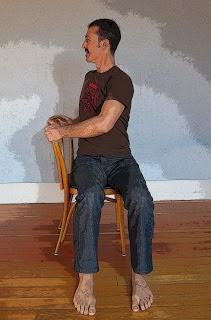 This pose releases back muscles that are stiff or sore from sitting at a desk or from traveling, or from everyday activities that stress the back, such as gardening and painting, and increases the rotational mobility in your spine. Twisting also helps nourish the spine—movement of the spine helps maintain the health of the discs—and also strengthens the bones themselves as your back muscles pull on the bony insertions of the spine. And it also strengthens the oblique muscles of your core. If you have a history of low back problems, please do this pose with a block between your thighs and twist only from the navel on up.
This pose releases back muscles that are stiff or sore from sitting at a desk or from traveling, or from everyday activities that stress the back, such as gardening and painting, and increases the rotational mobility in your spine. Twisting also helps nourish the spine—movement of the spine helps maintain the health of the discs—and also strengthens the bones themselves as your back muscles pull on the bony insertions of the spine. And it also strengthens the oblique muscles of your core. If you have a history of low back problems, please do this pose with a block between your thighs and twist only from the navel on up. 6. Easy Inverted Pose (see Easy Inverted Pose).
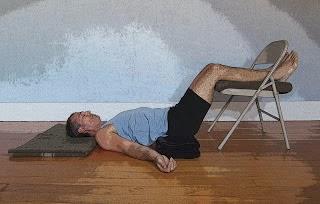 Resting your calves on a chair with a support under your pelvis puts your body into a slightly inverted position, so the blood flows from your legs down toward your heart making this pose is a very calming inversion, which is also very restful for your leg muscles. If the support under your pelvis irritates your lower back, you can simply do the same pose without it.
Resting your calves on a chair with a support under your pelvis puts your body into a slightly inverted position, so the blood flows from your legs down toward your heart making this pose is a very calming inversion, which is also very restful for your leg muscles. If the support under your pelvis irritates your lower back, you can simply do the same pose without it.NOTE: If you're reading this on the day it was posted, keep your eye out for a second post that recommends a weekly routine, including this sequence, for one of our readers that would be beneficial for anyone with back problems or who just wants to start practicing yoga at home.

